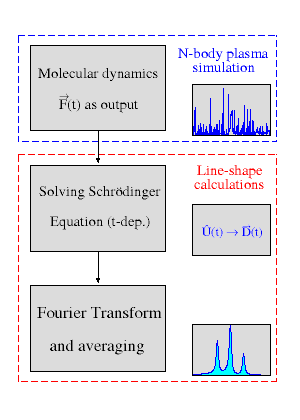Computer simulations
Introduction
Lately, a clear trend in the development and applications of line-broadening calculations is a significant increase in the computational results, in particular, using computer simulations [1].
Computer simulation is the discipline of designing an abstract model of an actual physical system, executing the model on a computer, and analyzing the execution output. The scale of models being simulated by computer simulations today far exceeds anything possible (or perhaps even imaginable) using traditional paper-and-pencil mathematical modeling.

Method
The calculations [2] are split into two largely independent computational pieces. The first one is the molecular-dynamics N-body simulation that models the motion of plasma particles. The fields produced at the radiators, as a result of the essentially chaotic motion of the plasma particles modeled, are stored as a function of time for a subsequent use in the second computational piece. The latter piece treats these "field histories'' as a time-dependent perturbating potential while solving the Schrödinger equation for a radiating atom.
The method is rather unique in its universality and in the broad scope of effects included, naturally accounting for all frequency regions of the plasma-particle fields and for the effects of the particle interactions, being applicable to line-shape calculations of isolated and overlapping spectral lines involving both dipole-allowed and dipole-forbidden radiative transitions under a simultaneous influence of externally-applied (constant or time-dependent) electric and magnetic fields in both weakly and strongly coupled plasmas.
Applications
The method has been used for benchmarking competing Stark-broadening theories [3], analyzing the influence of the correlations effects on the line shapes in plasmas [2,4], spectroscopic analysis of radiation-heated foams [5,6], state-of-the-art accurate atomic-data measurements [7], and 3D-mapping of fluctuating electric fields in pulsed plasmas [8].
References
-
Plasma line broadening and computer simulations: A mini-review
-
A study of ion-dynamics and correlation effects for spectral line broadening in plasma: K-shell lines
-
Stark broadening of high principal quantum number hydrogen Balmer lines in low-density laboratory plasmas
-
Correlation effects and their influence on line broadening in plasmas: Application to Hα
-
J. E. Bailey, G. A. Chandler, G. A. Rochau, Y. Maron, S. A. Slutz, G. S. Dunham, I. Golovkin, P. W. Lake, R.W. Lemke, J. M. Lucas, J. J. MacFarlane, T. A. Mehlhorn, T. C. Moore, D. G. Schroen, E. Stambulchik, and K. YoungbloodTime- and space-resolved spectroscopy of dynamic hohlraum interiors
-
G. A. Rochau, J. E. Bailey, Y. Maron, G. A. Chandler, G. S. Dunham, D. V. Fisher, V. I. Fisher, R. W. Lemke, J. J. MacFarlane, K. J. Peterson, D. G. Schroen, S. A. Slutz, and E. StambulchikRadiating Shock Measurements in the Z-Pinch Dynamic Hohlraum
-
Determination of the Li I 4d-4f Energy Separation Using Active Spectroscopy
-
Electric fields in plasmas under pulsed currents
^ Top
Modified on: 2012-12-20
Previous page: Line-broadening calculations
Next page: Macroscopic simulations




